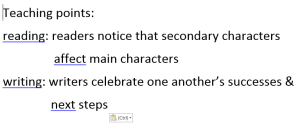“Learning Illustrated”
For the fourth week in EDU 6120, we are asked to write on the following prompt learning illustrated. This week’s learning covered some of the major thinkers of the Roman era and included readings by the historic figures Plutarch, and Quintillion. We also had a reading, Educational Reform, by Arthur Ellis. After completing the readings and listening to the online podcast, the terms classroom management, building relationships, and school climate were brought to mind.
From the Plutarch reading, The Education of Children, I enjoyed reading about his thoughts on the treatment of children. Plutarch suggest that we should encourage children in a positive manner, yet this encouragement should be based on reality of their skills. He also mentions that it is best to lift a student up when they are down and make sure to bring them down or utilize this time to correct them if they are too high. Interacting with students in this manner will assist us in trying to create the Plutarch ideal of a student that might be able to be a “master of his passions”. I want to make sure my interactions with students are overwhelmingly positive in nature. I want to do this by building up their skills and enabling them to have success in the classroom by providing instruction that is at their current level. I would like to celebrate success with them as well but also let them know that there is more to accomplish. I also really like the thoughts of remaining balanced to the high’s and low’s that we all face, not just in the classroom, but in life.
From the The Institutes of Oratory (sel.), by Quintilion, I also found some of his comments related well in regards to classroom management and building relationships. Quintilion suggest that teachers should have a “parental attitude towards pupils” and the majority of our talk should be “discourse on what is good and honorable” (Book II). This also aligns well with my desire to be focused on what students strengths are and building them up accordingly. Finding out my students’ strengths, and interest, and utilizing these in instruction will allow me create the positive environment that students will enjoy being a part of and put forth good effort. The relationship will also be firm yet caring with high expectations.
The Arthur Ellis reading, Educational Reform, highlights the importance of creating learning environments that have good order and control of discipline problems. The overall school climate can be a gauge in the level of success of the students. Establishing rules and procedures with the students and being consistent with enforcing these rules will be at the forefront of my interactions with students. When presented with challenging disruptive behavior, I will need to be able to quickly deal with this behavior in a positive manner. I can do this by making sure that I am commenting on the good behaviors of students, yet, I must ensure that I am also making corrections that will allow my students to know that I am doing so based on the high expectations that I have for them. I will make sure to build strong connections with students that are struggling and encourage and support them by sharing my belief in their abilities.
References
“The Education of Children” by Plutarch (46-120 AD)
The Institutes of Oratory (sel.), byQuintilion (35-95 AD)
Educational Reform, by Arthur Ellis
